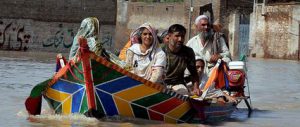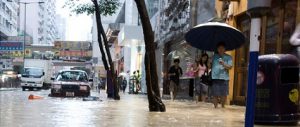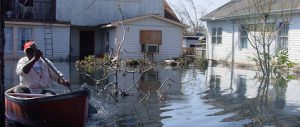In early June – against the backdrop of severe flooding in both the United States and China – delegates from governments, NGOs and international institutions convened in the Norwegian capital, Oslo, for the Nansen Conference. The title: “Climate change and displacement in the twenty-first century”. Speaking on the sidelines of the summit, Margareta Wahlström, special representative of the UN secretary-general for disaster-risk reduction told Meng Si why being prepared is not just a poor-country challenge and why individuals – as well as governments – must take action.
Meng Si: Why should governments – particularly in developing countries – prioritise disaster preparedness when they have so many issues to tackle, so many areas in which to spend money?
Margareta Wahlström: I think there are two obvious reasons. The first is a humane one: any government should protect people from getting killed. That’s the simplest version and I think any government will say, yes, we have to do that. Second, as a consequence it is an issue of social stability. Citizens feel the government should care about them, even if they are poor and even if the government doesn’t have many resources.
Then, of course, there are economic reasons. Every disaster costs money; every disaster has an impact on economic and development investment. If there are floods every year, perhaps we have even worse problems – every year the roads are damaged, maybe the bridges break down, maybe the hospital is damaged. It costs money. Simple and good national economic consideration is needed. Flooding regulation is an example.
Infrastructure is different in different countries, but the quality of infrastructure should be decided by national standards. I don’t think anyone can say, internationally, this is the way it has to be done, because it depends on the geography, the climate, the level of ambition.
MS: There has been displacement due to environmental change since the start of human civilisation. What do you think is special about the current climate-induced displacement?
MW: There are more people living on earth than ever before. It’s getting crowded. The space that we can go to – where there is water, agricultural land – is not as much as it used to be. Secondly, because everyone wants to live in cities, we are crowding together in a very limited space. Living in cities is actually quite economical: we are making use of smaller space. But because a lot of big cities in the world are along coastlines, they are very vulnerable to cyclones, typhoons, storms and, particularly on deltas, to sea-water infiltration. The above reasons makes the period unique.
Most cities in the world have been growing fast, and they didn’t know they would become so big. And so they haven’t planned efficient infrastructure for these types of growth and these types of extremes.
All over the world, there are reports pointing out that infrastructures are poorly maintained and in poor repair. That’s why sometimes you see bridges collapse in the United States. Almost no place in the world invests enough in repair and maintenance.
MS: Do you think it’s because governments are short-sighted?
MW: Government consists of individuals. So, how much do you and I invest in property repair? How much do you spend looking after your bicycle and polishing and cleaning it? Governments are like people in this way – they make shortcuts. They don’t think about 20 years from now, or 50 years. They think about the next five years. And in building a new bridge they may compromise, because it’s expensive.
MS: What do you think displacement means to individuals, especially when the government is not making the right preparations?
MW: Displacement is usually of a sudden: people lose their personal or family belongings; they have to run away quickly; they can’t take things with them. So, of course, it’s really stressful. Uncertainty is stressful. They don’t know if they can go back, or see their families, or go back to school. So the important thing is information – from either the authorities or somebody else – that keeps everybody well informed of what’s happening, whether they are able to go back, how long they will be relocated for. And, of course, people will be worrying about the loss: do they have insurance? Who can help them to rebuild their house?
I think displacement is not a very positive experience, for sure, but can it become less stressful? If the government and the authorities have thought about how to keep people informed, how to engage them in where they go, how they leave, and if the displacement is going to be long term. If you choose to leave, it’s your choice, but if you haven’t chosen to leave, I think it’s really crucial for people to be engaged in finding long-term solutions. There are [displaced] people who are fine – the places are OK, if you find a job, you find a way of living, you have a house, you can go to school, you can adjust. But still the fact is that it was not the people’s choice, it was a push.
MS: If the government is not doing enough to prepare for disaster, what should people do on an individual level?
MW: If you have insurance for your property and your life, that’s one way. Also, I think individuals can know more about the risks where they are living: is it an earthquake area? How close are you to the coastline? Where are the nearest hospitals? Have you thought about evacuation? Do you know how to get out of your building? Do you know how to behave in an earthquake? All these are important for individual preparedness.
You’ve seen the Japanese – they all have the evacuation kit, the things they need if they have to run very quickly. It’s a good preparedness measure in earthquake areas. It keeps you remembering.
MS: You have a lot of experience in disaster risk reduction. Have you seen any successful cases of preparation, or any lessons learned from disasters?
MW: The March 11 earthquake in Japan. If Japan had not been working on preparedness and early warnings for so many years, many more people would have died. They have really stringent building codes. It was a very strong earthquake, but not many buildings collapsed. In Tokyo, the buildings swung – they didn’t collapse – because they were built for the strongest earthquake. In any other country, it would have caused enormous damage. What the Japanese had not known was the impact on the nuclear plants. That’s a very bad lesson learned.
Another successful case is Bangladesh. There was a very large cyclone in Bangladesh that probably killed well over 200,000 people in the 1970s. After that, they started to build systems, saying this must not be allowed to happen again. Forty years ago, when they started working on preparedness, they were not rich. But for all these years, they have systemically built the early-warning system. They have been training people, educating people. They have built evacuation shelters.
In the beginning, they had a lot of assistance from international organisations. But the critical turning point was when the Bangladesh government started investing its own resources.
MS: What about China?
MW: I think the same thing is gradually happening in China, and that’s why I think the Sichuan earthquake was important, because people protested against poor quality school buildings. Any government, as you can see now, is sensitive to public discontent.
Of course, people in China are wealthier than before. They are better informed. So they not only care about becoming richer, but also about having a better and safer life. It’s also from the perspective of how to ensure continued economic stability. You have to look after your investment, infrastructure and energy supply. So there’s a very strong economic motivation.
You have serious floods and droughts in China. China suffers from very serious water stress, water shortage for consumption, for agriculture, for industrial purposes. So managing water sources is a critical priority for the government. If you can’t manage that, it may have impact on your economic growth. So they may not call it preparedness, they may not call it risk reduction, but this is what they are doing.
MS: It seems that preparedness is not enough, not only in developing countries, but also developed nations – look at Hurricane Katrina or the European heat wave of 2003. What did these places do in terms of capacity building after the disasters happened?
MW: After the heat wave in Europe, what France – where the biggest number of people were killed – has done is develop a much better warning system. They forecast how the heat wave will move. When they do that, they warn people in advance, particularly the elderly and sick.
In 2003, they did not have air conditioning in some critical public facilities, like hospitals. Quite a lot of people suffered and even died because they didn’t cool down. There are two important things: one, is to be able to give advance notification, and two, appropriate behaviour – drink water, try to avoid the sun, try to keep indoors where it’s cool and so on.
Quite a lot of reasons why Hurricane Katrina went really wrong were institutional. There have been changes: building better infrastructure, firing irresponsible people.
The other thing is the quality of the dams. As you can see now with the flooding in the United States [on the Missouri River], it’s not only about the quality of the infrastructure, but also the investment, the ability to upgrade, the function now. The dams were maybe built 40, 50 years ago, and rivers and even the sea change their behaviour. The country has not invested enough in understanding how the rivers change and upgrading the infrastructure. I think they will only gradually do that, but for sure they will give it greater attention now. There are difficult times everywhere in this regard – not just in poor countries.
Meng Si is managing editor in chinadialogue’s Beijing office.
Homepage image from David Pedler shows Brisbane during the January floods.


